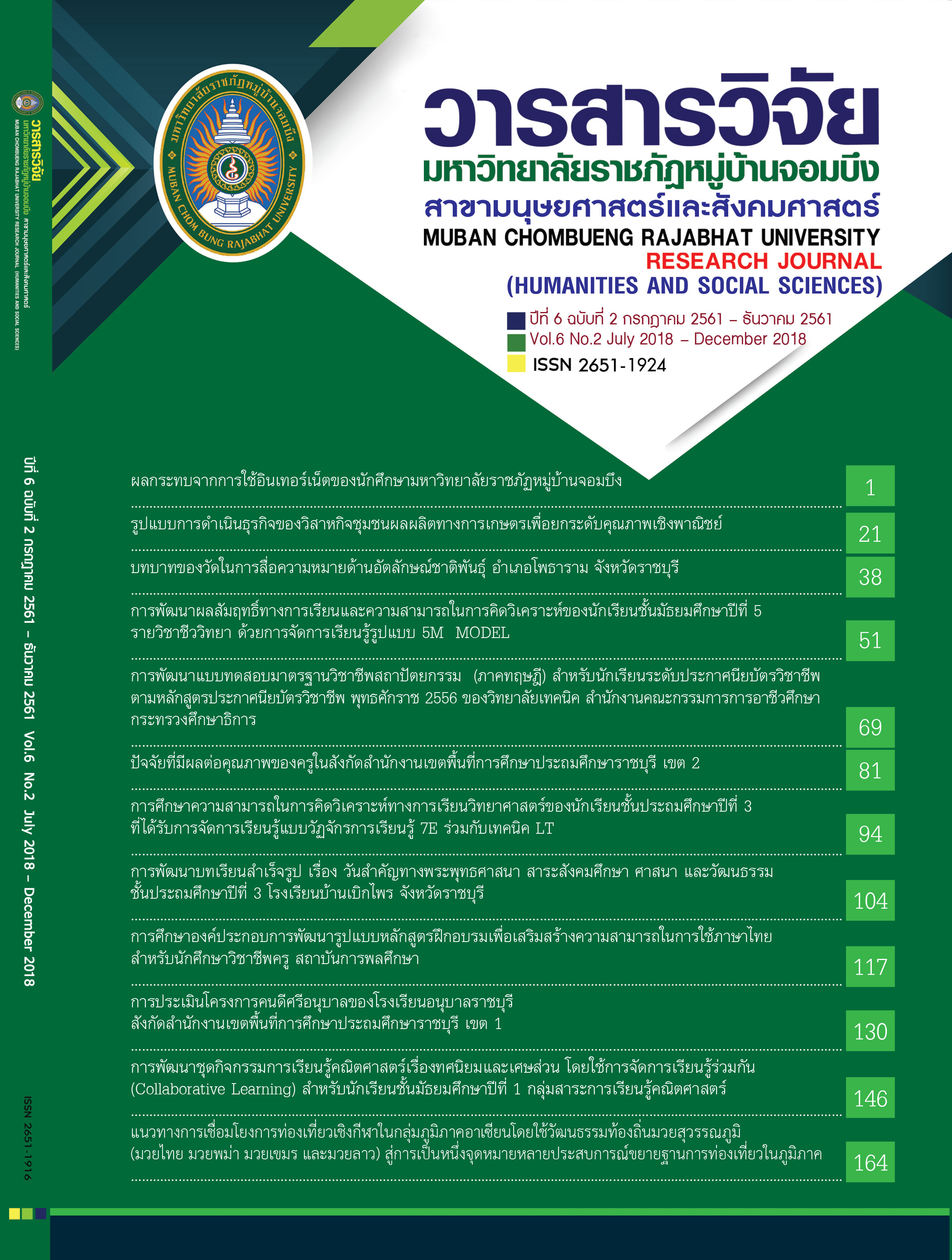แนวทางการเชื่อมโยงการท่องเที่ยวเชิงกีฬาในกลุ่มภูมิภาคอาเซียน โดยใช้วัฒนธรรมท้องถิ่นมวยสุวรรณภูมิ (มวยไทย มวยพม่า มวยเขมร และมวยลาว) สู่การเป็นหนึ่งจุดหมายหลายประสบการณ์ขยายฐานการท่องเที่ยวในภูมิภาค
คำสำคัญ:
การท่องเที่ยวเชิงกีฬา, มวยสุวรรณภูมิ, ภูมิภาคอาเซียนบทคัดย่อ
การวิจัยครั้งนี้มีวัตถุประสงค์เพื่อ 1) ศึกษาคุณลักษณะ พฤติกรรม และความต้องการของนักท่องเที่ยวเพื่อการเรียนรู้มวยสุวรรณภูมิ 2) ศึกษาศักยภาพและโอกาสในการพัฒนาการท่องเที่ยวเชิงกีฬาโดยใช้ศิลปะการต่อสู้มวยสุวรรณภูมิ 3) พัฒนากลไกในการเชื่อมประสานให้เกิดเครือข่ายการท่องเที่ยวเชิงกีฬาเชื่อมโยงในภูมิภาคอาเซียนโดยใช้มวยสุวรรณภูมิ 4) เสนอแนะแนวทางและวิธีพัฒนาเครือข่ายการท่องเที่ยวเชิงกีฬาในภูมิภาคอาเซียนโดยใช้มวยสุวรรณภูมิ และ 5) จัดทำแผนการจัดการเครือข่ายการท่องเที่ยวเชิงกีฬาโดยใช้มวยสุวรรณภูมิ เป็นการวิจัยแบบผสานวิธี เก็บข้อมูลเชิงปริมาณด้วยแบบสอบถามจากกลุ่มตัวอย่าง 2 กลุ่มคือ ชาวต่างประเทศที่มาเรียนมวยที่ได้ตรวจสอบความสมบูรณ์ของข้อมูลจากการประมวลผลข้อมูลด้วยโปรแกรมทางสถิติ จำนวน 446 คน และชาวต่างประเทศที่มาชมมวย จำนวน 400 คน วิเคราะห์ข้อมูลด้วยค่าร้อยละ ความถี่ ค่าเฉลี่ย ส่วนเบี่ยงเบนมาตรฐาน และทดสอบค่าเอฟ (f-test) เก็บข้อมูลเชิงคุณภาพด้วยการสัมภาษณ์เชิงลึกผู้ให้ข้อมูลหลักคือ ตัวแทนประธานสมาพันธ์มวย หัวหน้าค่ายมวย และผู้ทรงคุณวุฒิ จำนวน 35 คน ร่วมกับการสนทนากลุ่มย่อยผู้ทรงคุณวุฒิ จำนวน 20 คน วิเคราะห์ข้อมูลด้วยการวิเคราะห์เนื้อหา
ผลการวิจัย พบว่า นักท่องเที่ยวที่มาเรียนการชกมวยในประเทศไทยส่วนใหญ่มาฝึกมวยไทย (ร้อยละ 44.65) และต้องการความสะดวกในสถานที่ฝึกมวย (ร้อยละ 51.16) นักท่องเที่ยวที่มาเรียนการชกมวยในประเทศพม่าส่วนใหญ่มาฝึกมวยแลตเวย์ (ร้อยละ 43.21) และต้องการความสะดวกในสถานที่ฝึกมวย (ร้อยละ 81.25) นักท่องเที่ยวที่มาชมการชกมวยในประเทศไทย ส่วนใหญ่เดินทางมาเพื่อชมมวยไทยเพื่อความบันเทิงมวยไทย (ร้อยละ 46.51) และความต้องการในสนามมวยคือ บุคลากรมีอัธยาศัยดี (ร้อยละ 44.48) นักท่องเที่ยวที่มาชมการชกมวยในประเทศพม่า ทุกคนเดินทางมาเพื่อชมมวย (ร้อยละ 100) และความต้องการในสนามมวยคือ ตั๋วราคาไม่แพง มีจำนวนเท่ากับสถานที่มีมาตรฐานและมีความพร้อม (ร้อยละ 50) นักท่องเที่ยวที่มาชมการชกมวยในประเทศกัมพูชาส่วนใหญ่เดินทางมาเพื่อพักผ่อน (ร้อยละ 40.00) และความต้องการในสนามมวยคือ ตั๋วราคาไม่แพง (ร้อยละ 82.00) ด้านศักยภาพและโอกาสของสนามมวยในประเทศไทยภาพรวมอยู่ในระดับมาก ( =3.73) สนามมวยในประเทศกัมพูชาภาพรวมอยู่ในระดับปานกลาง ( =3.08) และสนามมวยในประเทศพม่าภาพรวมอยู่ในระดับมาก ( = 3.53) ศักยภาพและโอกาสของค่ายมวยในประเทศไทยภาพรวมอยู่ในระดับมาก ( =4.16) ค่ายมวยในประเทศพม่าภาพรวมอยู่ในระดับมาก ( =3.76) กลไกประสานให้เกิดเครือข่ายการท่องเที่ยวเชิงกีฬา ได้แก่ มีมุมมองเหมือนกัน มีวิสัยทัศน์ร่วมกัน กำหนดกลไกและการจูงใจ จัดหาทรัพยากร และให้ความช่วยเหลือประเทศสมาชิก โดยมีเครือข่ายมวยสุวรรณภูมิที่สำคัญ 5 เครือข่าย ได้แก่ เครือข่ายมวยสมัครเล่น เครือข่ายกีฬามวยอาชีพ เครือข่ายระหว่างบุคคล เครือข่ายธุรกิจมวย และเครือข่ายด้านวัฒนธรรม แนวทางและวิธีพัฒนาเครือข่ายการท่องเที่ยวเชิงกีฬาคือ แยกกีฬาออกจากวัฒนธรรม ปรึกษากันแบบมีส่วนร่วม สร้างองค์กรเครือข่ายมวยสุวรรณภูมิ จัดทำกติการ่วมกัน วางแผนทำงานร่วมกัน จัดหางบประมาณสนับสนุนภารกิจของเครือข่าย และจัดกิจกรรมต่าง ๆ ด้านแผนการจัดการเครือข่ายการท่องเที่ยวเชิงกีฬาโดยใช้มวยสุวรรณภูมิ มีจำนวน 7 แผน ได้แก่ แผนการสร้างความรู้ความเข้าใจมวยสุวรรณภูมิ แผนการจัดตั้งองค์กรมวยสุวรรณภูมิ แผนบริหารจัดการ แผนสนับสนุนจากภาครัฐและเอกชน แผนการแบ่งปันทรัพยากร แผนการตลาด และแผนการเชื่อมโยงมวยสุวรรณภูมิกับการท่องเที่ยว
เอกสารอ้างอิง
คณะกรรมการท่องเที่ยวแห่งชาติ. (2560). แผนพัฒนาการท่องเที่ยวแห่งชาติฉบับที่ 2 พ.ศ. 2560-2564. กรุงเทพฯ: สำนักงานปลัดกระทรวงการท่องเที่ยวและกีฬา.
ชูศรี วงศ์รัตนะ. (2550). เทคนิคการใช้สถิติเพื่อการวิจัย (พิมพ์ครั้งที่ 10). นนทบุรี: ไทยเนรมิตกิจอินเตอร์ โปรเกรสซิฟ.
ธรรมสรณ์ ตันกายา. (2560). ศิลปะการป้องกันตัวของกลุ่มชาติพันธุ์ออสโตรเอเชียติกเพื่อยุทธศาสตร์ การต่อยอดวัฒนธรรมมวยไทย. ดุษฎีนิพนธ์หลักสูตรปรัชญาดุษฎีบัณฑิต สาขาวิชายุทธศาสตร์การพัฒนาภูมิภาค (สมาธิมวยไทยและศิลปะการป้องกันตัว) มหาวิทยาลัยราชภัฏสุรินทร์.
พจนก กาญจนจันทร. (2555). จินตนาการ “สุวรรณภูมิ”. ใน สุดแดน วิสุทธิลักษณ์ (บรรณาธิการ).
25 ปีพิพิธภัณฑ์ธรรมศาสตร์เฉลิมพระเกียรติ พ.ศ. 2530-2555. กรุงเทพฯ: คณะสังคมวิทยาและมานุษยวิทยา มหาวิทยาลัยธรรมศาสตร์.
บุญชม ศรีสะอาด. (2553). การวิจัยเบื้องต้น (พิมพ์ครั้งที่ 5). กรุงเทพฯ: สีวิริยาสาส์น.
พบพร โอทกานนท์ และเยาวภา ปฐมศิริกุล. (2556). รูปแบบคุณภาพการบริการ ภาพลักษณ์แหล่ง
ท่องเที่ยวและความพึงพอใจที่ส่งผลต่อความตั้งใจเชิงพฤติกรรมการท่องเที่ยวแบบพำนักระยะยาวของชาวยุโรปและอเมริกัน. วารสารธรรมศาสตร์, 32(1), 35-56.
ราชบัณฑิตสถาน. (2556). พจนานุกรมฉบับเฉลิมพระเกียรติ พ.ศ. 2555. (2556). กรุงเทพฯ: ผู้แต่ง.
รายาศิต เต็งกูสุลัยมาน, วรรณา พิทักษ์ศานต์, และกานตินุช สถิรมนัส. (2554). รายงานวิจัยฉบับสมบูรณ์ โครงการมวยไทย : นวัตกรรมเชิงพาณิชย์นอกฤดูการท่องเที่ยวพื้นที่อันดามัน. กรุงเทพฯ: สำนักงานกองทุนสนับสนุนการวิจัย.
วิกิพีเดีย สารานุกรมเสรี. (2561). สุวรรณภูมิ. สืบค้นเมื่อ 23 กันยายน 2561, จาก https://th.wikipedia.org/wiki/สุวรรณภูมิ.
สำนักงานสถิติแห่งชาติ. (2555). เทคนิคการสุ่มตัวอย่างและการประมาณค่า. กรุงเทพฯ: กลุ่มระเบียบวิธีสถิติ สำนักนโยบายและวิชาการสถิติ.
สุชาติ อิทธิวรรณพงศ์. (2551). ภาพลักษณ์มวยไทยในสายตาชาวต่างชาติและกลยุทธ์การสื่อสาร การตลาดของค่ายมวยไทย. การศึกษาค้นคว้าอิสระ บริหารธุรกิจมหาบัณฑิต บัณฑิตวิทยาลัย, มหาวิทยาลัยกรุงเทพ.
สุภางค์ จันทวานิช. (2551). การวิเคราะห์ข้อมูลในการวิจัยเชิงคุณภาพ (พิมพ์ครั้งที่ 8). กรุงเทพฯ: สำนักพิมพ์แพ่งจุฬาลงกรณ์มหาวิทยาลัย.
อรุณ จิรวัฒน์กุล. (2551). ชีวสถิติสำหรับงานวิจัยทางวิทยาศาสตร์สุขภาพ (พิมพ์ครั้งที่ 3). ขอนแก่น: ภาควิชาชีวสถิติและประชากรศาสตร์ คณะสาธารณสุขศาสตร์ มหาวิทยาลัยขอนแก่น.
Barandela, J., S., Barajas, A., Alén, E., & Fernández, P., S. (2014). Modelling of Sport Events and Their Use to Increase Tourism and Economic Impact. Retrieved September 1, 2018, from Sport Tourism Conference 2014 - STC’14. Website: https://www.researchgate.net/publication/282851985_MODELLING_OF_SPORT_EVENTS_AND_THEIR_USE_TO_INCREASE_TOURISM_AND_ECONOMIC_IMPACT.
Edrak, B., Nor, Z. M., & Maamon, N. M. (2016). Is Sport Tourism Policy still Relevant to the Nation Economic Policy? Retrieved September 1, 2018, from International Journal of Consumer Policy, 6(1), 1-11. Website: https://www.ripublication.com/ijcp16/ijcpv6n1_01.pdf.
Higham, J. ( 2005). Sport books tourism destination. Tokyo : Elsevier, Butter Worth- Heinemanu.
Phuong Anh, D., T. (2014). The Relationship between a Mega Sport Event and the Host Destination. International Journal of Tourism Sciences, 14(3), 116-129.
Thanh, L., Q. (2017). A Study on the Status of Sport Tourism Development in Vietnam. Journal of Sports Science, 5(-), 219-226.
Wikipedia. (2018). Indochinese_martial_arts. Retrieved September 23, 2018, from https://wikipedia.org/wiki/Indochinese_martial_arts.
ดาวน์โหลด
เผยแพร่แล้ว
รูปแบบการอ้างอิง
ฉบับ
ประเภทบทความ
สัญญาอนุญาต
วารสาร TCI อยู่ภายใต้การอนุญาต Creative Commons Attribution-NonCommercial-NoDerivatives 4.0 International (CC BY-NC-ND 4.0) เว้นแต่จะรุบุไว้เป็นอย่างอื่นโปรดอ่านหน้านโยบายของเราสำหรับข้อมูลเพิ่มเติมเกี่ยวกับการเช้าถึงแบบเปิด ลิขสิทธิ์ และการอนุญาต



